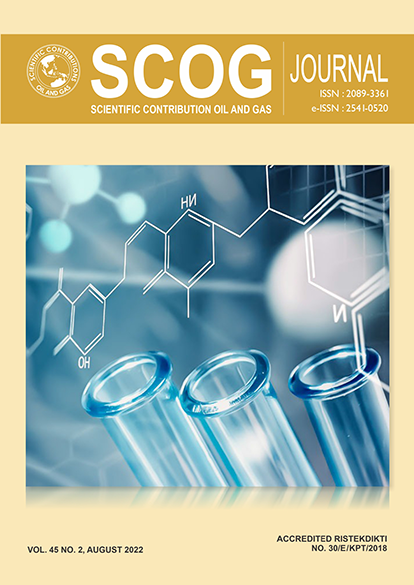Converting Catalytic Palm Oil (MEPO) to Produce Biogasoline Using Zeolite Faujasite Catalyst From Fly Ash with Nickel Impregnation (Ni)
DOI:
https://doi.org/10.29017/SCOG.45.2.1187Keywords:
faujasite, impregnation, nickel, hydrocracking, biogasoline.Abstract
The process hydrocracking methyl ester of palm oil into fractions biogasoline by faujasite cata-lyst of fly ash impregnated with nickel have been made. Preparation for faujasite synthesis of fly ash can be
done by removing organic compound and refluxing HCl. Synthesis do by melting the fly ash which has been
prepared with NaOH 1: 1.2 and in aging for 8 hours and in the hydrothermal autoclave for 24 hours. The char-
acter faujasite using XRD and Si / Al ratio produces crystallinity main peak of 67% and Si / Al ratio of 1.65.
Hydrocracking process using a variety of 4 catalyst used fly ash leaching results, faujasite, Ni-Faujasite 2%, and
Ni-Faujasite 4%. Test the activity and selectivity of the catalyst to produce liquid product analyzed by GC-MS
with the best catalyst was Ni-Faujasite 4% to yield 42.34% of the activity and selectivity of biogasoline frac-
tion of 7.12%. The impregnation of the nickel catalyst is made by soaking in salt of nickel and then oxidation
using O2 gas and reduction using H2 gas. The impregnation of nickel will affect the character of the catalyst
so that the activity and selectivity of the catalyst is changed. The impregnation of nickel 4% on faujasite suc-
cessfully done with nickel content of 3.71%, increasing Si / Al ratio of 2.27 and an acidity of 0.0035 mol/g.
References
Baerlocher, C.H. (2007). Atlas Of Framework Types Of
Zeolit. Amsterdam: Elsevier Science.
Bartholomew, C.H. (2006). Fundamental Of Industrial
Catalytic Process. New Jersey: John Wiley And Sons
Inc.
Fansuri, Hamzah. (2015). “The Effect of Carbon on
the Formation of Zeolite from Bottom Ash Using
theHydrothermal Methodâ€. Not Published. Thesis.
Surabaya: ITS.
Farouq, Noor, Zubaidi dan Bhatia. (2009).“Catalytic
Conversion of Palm Oil to Hydrocarbons: Performance
of Various ZeolitCatalysts, Industrial and Engineering
ChemistryResearchâ€. Jurnal Chemistry Research, 38
(9):3230-3237.
Hamdan, H. (1992). Introduction to Zeolites: Synthesis,
Characterization, and Modification. Penang:Universiti
Teknologi Malaysia.
Handoko, D.S.P. (2001). “Modification of Natural Zeo-
lite and Its Characterization as a Cracking Catalyst
for Liquid Smoke Bengkirai Woodâ€. Not Published.
Thesis. Yogyakarta: Gajah Mada University.
Handoko, DSP, Nehemia Fernandes Kristianto dan
Wuryanti Handayani,†pemanfaatan Limbah Tem-
bakau (Nicotiana Tabacum) Pasca Panen Sebagai
Biodiesel Alternatif “, Lembaran Publikasi Minyak
dan Gas Bumi, Vol 51, Nomor 3, Desember 2017,
Lemigas, Jakarta.
Handoko, Triyono, Narsito, Dwi. (2009). Improvement
of Cooking Oil Quality Using H5-NZA Adsorbent in
Fluid Fixed Bed System Reactor. Journal of Basic
Sciences. Vol. 10(2):121-132.
Hayat, R. (2007). “Study of the Catalytic Activities of
H5-NZA, Co(III)/H5-NZA, and Ni(II)/H5-NZA in
Catalytic Cracking of Methyl Esters of Castor Oil
(Jatropha curcas)â€. Not Published. Thesis. Jember:
University of Jember
Junaidi, Haliq. (2011). “Activity and Selectivity Test of
Ni/H5NZA Catalyst in the Hydrocracking Process of
Palm Oil Methyl Esters (Mepo) into Short Fraction
Liquid Hydrocarbon Compoundsâ€. Not Published.
Thesis. Jember: University of Jember.
Las, Tamzil. (2004). “Use of Zeolite in Industry and
Environmentâ€. Proceedings of the National Zeolite
V Seminar in Bandar Lampung. 2006. Gadjah Mada
University 5:20-28.
Nino, Victor. (2013). “Application of faujasite synthesized
from illite to the removal of Cr3
+ and Ni2
+ from elec-
troplating wastewaterâ€. Journalrev.ion. 26(2):7-15.
Paiton, PJB. (2002). Material Safety Data Sheet.
Probolinggo : PT. Pembangkitan Jawa Bali Unit
Pembangkitan Paiton.
Rodhie, Saputra. (2006). Utilization of Synthetic Zeolite
as an Alternative for Industrial Waste Treatment. Not
published. Papers. Yogyakarta: UGM
Satterfield, C.N. (1980). Heterogenous Catalysis in
Practices. New York: McGraw.
Somerset, V. (2004). “Alkaline Hydrothermal Zeolits
Synthesized From Fly ash SiO2 And Al2O3â€. Journal
Department of Chemistry, 84(2005): 2324–2329.
Sutarno, 2004. “Faujasite Synthesis from Coal Fly Ash:
Effect of Reflux and Coal Fly Ash Crushing on Fauja-
site Crystallinityâ€. Journal of Mathematics and Science
, 9 (3): 285-290.
Sutarno, (2007). “Synthesis Of Faujasite From Fly ash
And Its Applications For Hydrocracking of Petroleum
Distillatesâ€. Journal Bulletin of Chemical Reaction
Engineering & Catalysis, 2(2-3): 45-51.
Sutarti, M and Rachmawati, M. (1994). Zeolite Litera-
ture Review. Jakarta: LIPI PDIII.
Tovina, Hany. (2009). “Synthesis of Faujasite Type
Nanozeolite with Seeding Technique grown on Glassy
Carbon Surfaceâ€. Not published. Thesis. Depok: Uni-
versity of Indonesia.
Ulfah, Eli Maria. (2006). “Optimization of Zeolite X
Catalyst Manufacturing from Alum, NaOH dan Wa-
ter Glass Dengan Response Surface Methodologyâ€.
Journal Bulletin of Chemical Reaction Engineering
& Catalysis, 1(3): 26-32.
Wulansari, D. (2004).“ Study of Ni/ZAAH5 Catalyst
Activity on Conversion of Used Cooking Oil into
Liquid Fuel Fractionâ€. Not Published. Thesis.Jember:
University of Jember.
Yusman, Ika. (2012). “Activity and Selectivity of Ni/
H5-Nza Catalyst in Cracking Palm Oil into Short Frac-
tion Liquid Hydrocarbon Compounds. Not Published.
Thesis. Jember: University of Jember.
Downloads
Published
Issue
Section
License
Copyright (c) 2023 SCIENTIFIC CONTRIBUTIONS OIL AND GAS (SCOG)

This work is licensed under a Creative Commons Attribution 4.0 International License.
Authors are free to Share — copy and redistribute the material in any medium or format for any purpose, even commercially Adapt — remix, transform, and build upon the material for any purpose, even commercially.
The licensor cannot revoke these freedoms as long as you follow the license terms, under the following terms Attribution — You must give appropriate credit , provide a link to the license, and indicate if changes were made . You may do so in any reasonable manner, but not in any way that suggests the licensor endorses you or your use.
No additional restrictions — You may not apply legal terms or technological measures that legally restrict others from doing anything the license permits.














